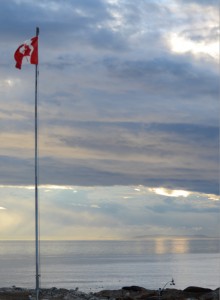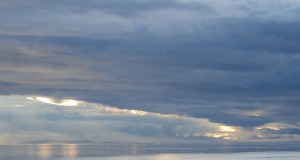Friday, a northeast wind blew 5 – 10 knots, most of the day. It turned to west in the evening and was stalled several times. It was first (for us), seeing the light tower wind gauge read 0.00 knots. By Saturday morning it was coming in from the north at 5 – 10 knots. Saturday afternoon, the direction swung through southwest to south and by evening it was back to west. The barometric pressure started falling in the wee hours of Friday morning, a drop that continued on the same trajectory Friday and Saturday, going from a little above 1016 hPA to 1010 hPA. Although the forecasts change considerably from time to time during the period of a couple of days, a gale warning continues to be in effect and it is expected to turn to west and blow 30 – 40 knots Sunday afternoon. The rain continues to threaten and is supposed to end Sunday evening, that is, if it really gets started.
Friday there were only two commercial visits observed in the Ecological Reserve. Saturday morning, 30 – 40 Southern Resident Killer Whales were sighted by whale watching operators, off Beechey Head to the west of Race Rocks. There was also a Humpback Whale diving between there and Race Rocks. Once the sightings were reported by VHF radio, the fleet was alerted and commercial whale watching vessels started heading to the locations. Commercial traffic became fairly heavy with 28 tour boat visits inside the Ecological Reserve, observed Saturday.
Observing vessels that operate in the reserve daily, and making reports to BC Parks and Fisheries and Oceans Canada are routine Eco-guardian tasks. This gives me some insight into how sustainable different commercial operators are, in their use of Race Rocks Ecological Reserve. Distributing a sustainability rubric based on the agreement with the whale watching industry, Fisheries Act, Marine Mammal Regulations and BC Parks regulations might be a good way for vessel operators to grade themselves and their colleagues. Of course the same vessels don’t always have the same operator, but one gets a sense of company culture, as reflected in the way the vessels are run.
Most of the operators work carefully, respectfully and sustainably; they slow right down on entering the reserve and go even slower when there are seals and sea lions in the water. If there are whales in the Protected Area they do not enter into the Ecological Reserve and if a whale enters while they are inside they carefully and slowly leave using extreme caution to avoid interacting with the animals. They stay in the centre of Middle Channel going with the current and never try to wedge themselves between Great Race and South Islands (their insurance companies probably like this too). They are respectful, keeping their distance to the animals and acting as role models for other companies and vessels on the water. In the long run, this is good for business and good for the animals. It means that this kind of commercial activity might sustainably continue to use the Ecological Reserve.
If you are reading this and don’t know what an Ecological Reserve is – it is a protected area that offers the highest protection available within the BC Parks system. There is a lot of good information on the BC Parks Ecological Reserves website, on this website and in general on the Friends of Ecological Reserves website.
The sea lions were very well behaved Saturday after wreaking a bit of havoc yesterday. The two elephant seals had a good 36 hour sleep before going for a swim. As night fell, they were waiting for a chance to get back up the ramp amidst a crowd of California Sea Lions.
Alex and I accomplished a lot today, finishing some of the bigger, monthly chores and fighting entropy at every turn. There were no visitors.
- Saturday evening’s sky with the west wind showing off the Race Rocks flag.
- Patterns of clouds, sky and water.


